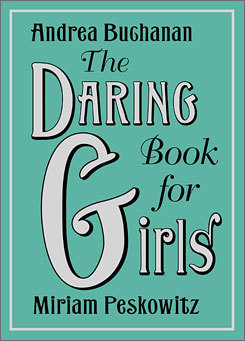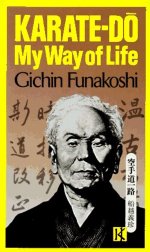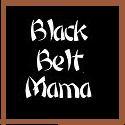The Daring Book for Girls
I can clearly recall the days I spent trying to make perfume and princess crowns out of dandelions. That was usually after a spirited game (or eight) of kick ball in the street, followed by an even more spirited game of freeze tag. When it was too hot, I’d sit on my porch and play cat’s cradle with a willing friend. School days brought Four Square and Tether Ball with a vivacity that would have told an observer that I was an Olympian and these were my sports. What a trip back in time "The Daring Book for Girls" was for me.
Childhood has definitely changed for girls and this book attempts to put it back to how it used to be. One can learn how to build things, paint and create origami. Girls can also learn some girl-power history in this book, like the story of Joan of Arc for just one example.
Some of my personal favorites include the following. During the "Rules of the Game: Softball" section, the authors write this:
"The first rule of softball is never to apologize. This may seem an odd way to introduce a sport, but many, many girls, and women, too, find themselves saying ‘I’m sorry’ if the ball they throw falls short, strays long, leaps out of bounds, or in any way doesn’t land exactly the way they intended. Try to resist this impulse. Unless your throw inflicts actual bodily harm, never apologize for an errant throw or catch. Now you’re ready to play."
I knew right then and there that the authors of this book, who happen to be the co-founders of Mother Talk, are truly my heroes. It wasn’t many more pages before I found yet another reason to love them. In the "Every Girl’s Toolbox" section, they’re not talking about lipstick and an eyelash curler, when they use the statement "Remembering the saying ‘righty-tighty, lefty-loosy’ will help you recall which direction to turn a screw." I used this handy little saying just yesterday as I tightened the screw on the hand-grip of my crutches. It’s practically been my tool mantra since Industrial Arts in the 7th grade!
I also loved the chapter called "The Girls Guide to Danger" where one of the "dangerous" things the authors recommend for girls is to "Stand up for yourself-or someone else." Thank you Andrea and Miriam! I must repeat this to my daughter every single week, and it’s something that is well worth repeating to young girls these days who will be walked all over if they don’t learn this simple concept early in life.
Hand in hand with this chapter is the one simply titled "Boys" which, when all is said and done, boils down to just one statement: "do treat all your friends, boys and girls, with kindness." That can’t be said enough. It has gone a bit out of style and that is a very sad thing.
In case you’re a bit forgetful when it comes to basic math, science, and history, "The Daring Book for Girls" also has a good dose of the basics. From the Periodic Table (with a mention of the elements that women were responsible for founding) to a history lesson on female pirates, this book has something for absolutely everyone.
My daughter and I spent some time perusing the book and she decided that she wanted to learn how to do a back walkover. For a girl who has trouble jump-roping (a sad commentary on society today in and of itself), I knew a walkover was pushing it. But that didn’t stop me from coaching her on the fundamentals of a back walkover, starting with a backbend.
Like Popeye the Sailor man, I believed that spinach was the key component to strength when I was little. After eating a healthy portion (while holding my nose to disguise the taste) I performed my first backbend from a standing position. I told my daughter that tale; and I now believe it is her mission in life to be able to do that as well. This book has clearly opened some doors for us.
I only have two issues/suggestions that would make the book better. Being a martial artist, I thought that the karate moves every girl should know were a bit lacking. Including more effective strategies such as: 1. a knee/kick to the groin, 2. a foreknuckle strike to the throat, 3. an eye gouge, 4, a front kick to the knee and 5. a headbutt with the back of the head to someone’s face, would definitely be more effective from a self defense perspective. Or, take the moves that are already included in the book and include some information on how you would appropriately use them, as in "kick ’em where it counts" for example. We can’t ignore the fact that we live in a different world today, and some basic self defense would have been a welcome asset to the book.
My only other critique is really a suggestion for the future. Because it’s sometimes difficult to read about how to do an activity and then do it, an accompanying DVD would be a fabulous addition. A demonstration of Four Square, the Hand Slapping rhyme that starts with "Miss Suzie had a steamboat", and a step by step guide to cat’s cradle would have been an exciting inclusion. Of course, I’m sensing that a sequel would be appropriate so maybe that could be included then.
I know that this book will become a treasured part of our family life for many years to come. It’s the type of book you want to share with every girl you know. I know I’ve had fun sharing it with my girls, and hopefully, with a little help from this book, they can become daring girls like their Mom.
If you’d like to purchase this book, go here. To find about more about the authors, go here and here.
BBM gives "The Daring Book for Girls". . .
![]()
To learn more about The BBM Review rating system, go here.
Karate-do: My Way Of Life – Gichin Funakoshi
Chances are, if you’re reading this that you have at least a passing interest in martial arts in one form or another. Maybe you train, maybe you used to train, or maybe you just like to watch the high-kicking, board breaking antics. Regardless of why you’re here and which style you might train in, the name Gichin Funakoshi is an important one, and one you should be aware of.
Funakoshi was the founder of one of the world’s biggest schools of karate, Shōtōkan-ryū, and he was Instrumental in bringing the original Okinawan martial arts to Japan and promoting and spreading the associated benefits to the land of the rising sun, and subsequently the rest of the world. This book is Funakoshi’s story in his own words, and despite being relatively short in terms of an autobiography (144 pages) he still manages to pack a huge amount of information in. Throughout the book his thoughts and experiences are related to the reader in the form of a series of anecdotes and stories from his colourful life, from sneaking through the back streets in the middle of the night as a young man for secretive training (and being mistaken for visiting ‘ladies of the night’!), to the second world war and destruction of the original Shōtōkan dojo, Funakoshi’s life is wonderfully depicted and paints a vivid picture of life in the late 19th/early 20th century in Okinawa and Japan.
If one had to find a fault with the book – and to be honest that’s not an easy job – you’d have to point at its brevity. It won’t take you a long time to read this book, and because of the way it’s written with anecdote following anecdote over the space of a few pages, it’s a real page-turner. It’s perfectly plausible to think that you could sit down one Sunday afternoon to start reading, only to find you’ve finished it before bedtime. Despite this though, it’s a delightfully entertaining and engrossing read, and testimony to the man who not only penned many of the original precepts of martial arts training which we still adhere to, but lived his life by them. Don’t expect in-depth analysis and insights into karate, this isn’t what this book is for and Funakoshi saved this for his master text, the Karate-do Kyohan. Instead enjoy a look back at the life of one of the true Fathers of modern-day martial arts, told in his own inimitable style.
TSDAdam gives this book a BBMReview rating of…
![]()










